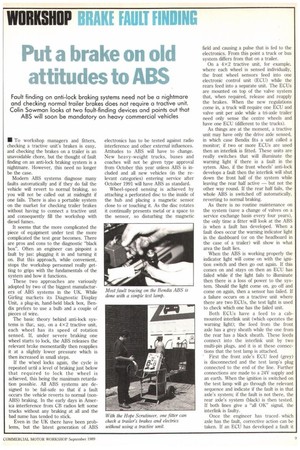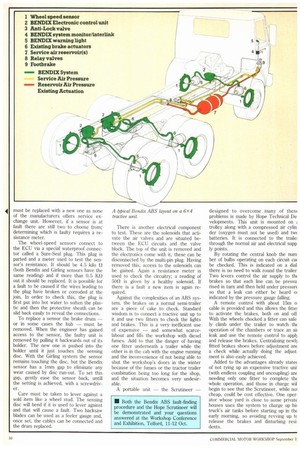Put a brake on old
Page 101

Page 102

If you've noticed an error in this article please click here to report it so we can fix it.
attitudes to ABS • To workshop managers and fitters, checking a tractive unit's brakes is easy, and checking the brakes on a trailer is an unavoidable chore, but the thought of fault finding on an anti-lock braking system is a nightmare. However, this need no longer be the case.
Modern ABS systems diagnose many faults automatically and if they do fail the vehicle will revert to normal braking, so you will not be called out at midnight if one fails. There is also a pornable system on the market for checking trailer brakes without having to connect a tractive unit and consequently fill the workshop with diesel fumes.
It seems that the more complicated the piece of equipment under test the more complicated the test gear becomes. There are pros and cons to the diagnostic "black box". Often an engineer can pinpoint a fault by just plugging it in and turning it on. But this approach, while convenient, stops the workshop personnel really getting to grips with the fundamentals of the system and how it functions.
These two approaches are variously adopted by two of the biggest manufactur ers of ABS systems in the UK. While Girling markets its Diagnostic Display Unit, a plug-in, hand-held black box, Bendix prefers to use a bulb and a couple of pieces of wire.
The basic theory behind anti-lock systems is that, say, on a 4x2 tractive unit, each wheel has its speed of rotation sensed. If, under severe braking one wheel starts to lock, the ABS releases the relevant brake momentarily then reapplies it at a slightly lower pressure which is then increased in small steps.
If the wheel locks again, the cycle is repeated until a level of braking just below that required to lock the wheel is achieved, this being the maximum retardation possible. All ABS systems are designed to be fail-safe so that if a fault occurs the vehicle reverts to normal (nonABS) braking. In the early days in Amer ica interference from CB radios left some trucks without any braking at all and the bad name has tended to stick.
Even in the UK there have been problems, but the latest generation of ABS electronics has to be tested against radio interference and other external influences. Attitudes to ABS will have to change. New heavy-weight trucks, buses and coaches will not be given type approval from October this year unless ABS is included and all new vehicles (in the relevant categories) entering service after October 1991 will have ABS as standard.
Wheel-speed sensing is achieved by attaching a perforated disc to the inside of the hub and placing a magnetic sensor close to or touching it. As the disc rotates it continually presents metal or a space to the sensor, so disturbing the magnetic field and causing a pulse that is fed to the electronics. From this point a truck or bus system differs from that on a trailer.
On a 4x2 tractive unit, for example, where each wheel is sensed individually, the front wheel sensors feed into one electronic control unit (ECU) while the rears feed into a separate unit. The ECUs are mounted on top of the valve system that, when required, release and reapply the brakes. When the new regulations come in, a truck will require one ECU and valve unit per axle while a tri-aide trailer need only sense the centre wheels and have one ECU (different to the trucks).
As things are at the moment, a tractive unit may have only the drive axle sensed, in which case Bendix fits a unit called a monitor; if two or more ECUs are used then an interlink is fitted. These units are really switches that will illuminate the warning light if there is a fault in the sytem. Also, if the front wheels' anti-lock develops a fault then the interlink will shut down the front half of the system while leaving the rear half active — but not the other way round. if the rear half fails, the whole ABS is switched off automatically, reverting to normal braking.
As there is no routine maintenance on the system (save a change of valves on a service exchange basis every four years), the only time a fitter will look at the ABS is when a fault has developed. When a fault does occur the warning indicator light in the dashboard (or on the headboard in the case of a trailer) will show in what area the fault lies.
When the ABS is working properly the indicator light will come on with the ignition switch and then go out again. If this comes on and stays on then an ECU has failed while if the light fails to illuminate then there is a loss of power to the system. Should the light come on, go off and come on again, then a sensor has failed. If a failure occurs on a tractive unit where there are two ECUs, the test light is used to check which one has the failed unit.
Both ECUs have a feed to a cabmounted interlink unit (which operates the warning light); the feed from the front axle has a grey sheath while the one from the rear has a black sheath. These feeds connect into the interlink unit by two multi-pin plugs, and it is at these connections that the test lamp is attached.
First the front axle's ECU feed (grey) is disconnected and the test lamp's plug connected to the end of the line. Further connections are made to a 24V supply and an earth. When the ignition is switched on the test lamp will go through the relevant sequence and indicate if the fault is in that axle's system; if the fault is not there, the rear axle's system (black) is then tested. If both lines give a "all OK" signal, the interlink is faulty.
Once the engineer has traced. which axle has the fault, corrective action can be taken. If an ECU has developed a fault it must be replaced with a new one as none of the manufacturers offers service exchange unit. However, if a sensor is at fault there are still two to choose from; determining which is faulty requires a resistance meter.
The wheel-speed sensors connect to the ECU via a special waterproof connector called a Sure-Seal plug. This plug is parted and a meter used to test the sensor's resistance. It should be 4.5 kilo 11 (both Bendix and Girling sensors have the same reading) and if more than 0.5 1{12 out it should be replaced. It is possible for a fault to be caused if the wires leading to the plug have broken or corroded at the join. In order to check this, the plug is first put into hot water to soften the plastic and then the protective sheath can be slid back easily to reveal the connections.
To replace a sensor the brake drum — or in some cases the hub — must be removed. When the engineer has gained access to the sensor, the faulty unit is removed by pulling it backwards out of its holder. The new one is pushed into the holder until it just touches the sensing disc. With the Girling system the sensor remains touching the disc, but the Bendix sensor has a lmm gap to eliminate any wear caused by disc run-out. To set this gap, gently ease the sensor back, untill the setting is achieved, with a screwdriver.
Care must be taken to lever against a sold item like a wheel stud. The sensing disc will bend if it is used to lever against and that will cause a fault. Two hacksaw blades can be used as a feeler gauge and, once set, the cables can be connected and the drum replaced. A typical Bendix ABS layout on a 6x4 tractive unit.
There is another electrical component to test. These are the solenoids that activate the air valves and are situated between the ECU circuits and the valve block. The top of the unit is removed and the electronics come with it, these can be disconnected by the multi-pin plug. Having removed this, access to the solenoids can be gained. Again a resistance meter is used to check the circuitry; a reading of 500 is given by a healthy solenoid. If there is a fault a new item is again required.
Against the complexities of an ABS system, the brakes on a normal semi-trailer are a piece of cake to check. Standard wisdom is to connect a tractive unit up to it and use two fitters to check the lights and brakes. This is a very inefficient use of expensive — and somewhat scarcelabour and fills the workshop with diesel fumes. Add to that the danger of having one fitter underneath a trailer while the other is in the cab with the engine running and the inconvenience of not being able to shut the workshop's doors in the winter because of the fumes or the tractor trailer combination being too long for the shop, and the situation becomes very undesirable.
A portable unit — the Scrutineer — designed to overcome many of these problems is made by Hope Technical De velopments. This unit is mounted on trolley along with a compressed air cylin der (oxygen must not be used) and twe batteries. It is connected to the trailet through the normal air and electrical supp ly points.
By rotating the central knob the num her of bulbs operating on each circuit cat be checked. This is indicated on a dial there is no need to walk round the trailer Two levers control the air supply to the brakes so that each line can be pressu rised in turn and then held under pressure so that a leak can either be heard a indicated by the pressure gauge falling.
A remote control with about 15m o cable is provided and this allows the fittei to activate the brakes, both on and off With the wheels chocked a fitter can safe ly climb under the trailer to watch the operation of the chambers or trace an ail leak and use the remote control to appl) and release the brakes. Centralising newl) fitted brakes shoes before adjustment am a check while actually doing the adjust ment is also easly achieved.
Added to the advantages already statec of not tying up an expensive tractive unit (with endless coupling and uncoupling) am needing only one fitter to complete the -whole operation, and those in charge wil begin to see that the Scrutineer, while not cheap, could be cost effective. One operator whose yard is close to some private houses uses the system to charge up hi truck's air tanks before starting up in the early morning, so avoiding revving up tc release the brakes and disturbing residents.
































































































































